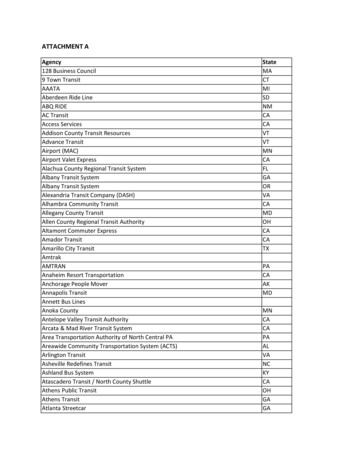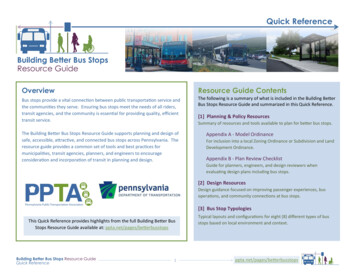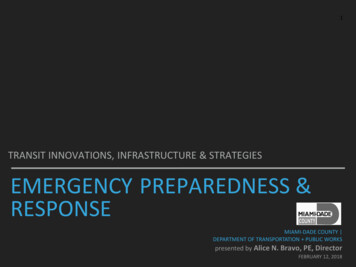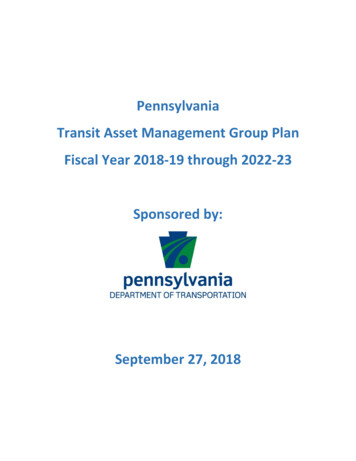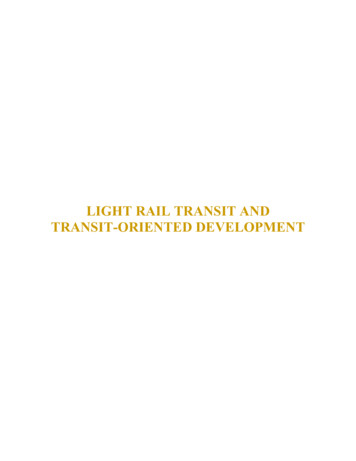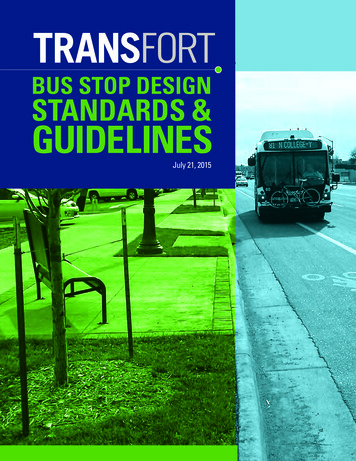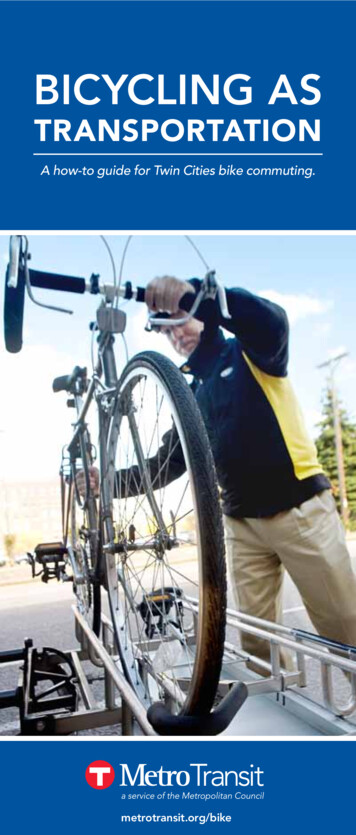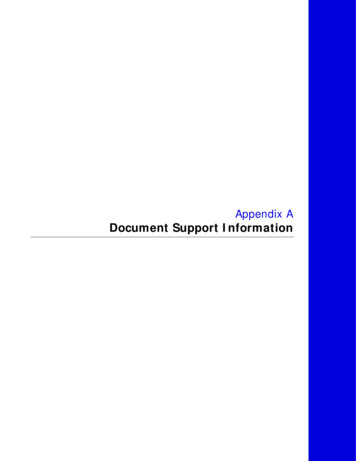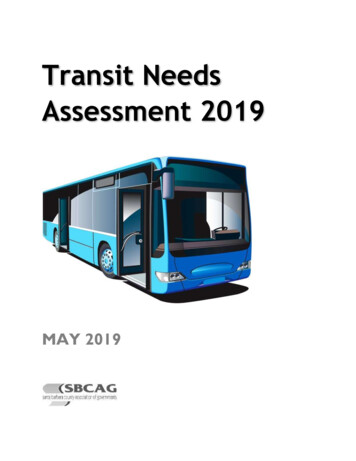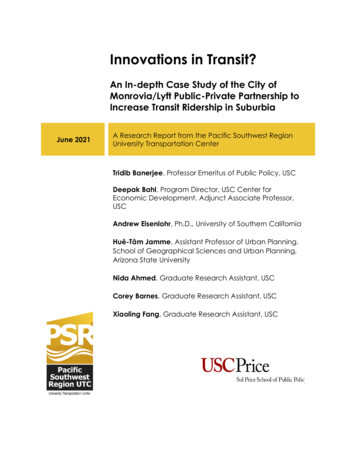
Transcription
Innovations in Transit?An In-depth Case Study of the City ofMonrovia/Lyft Public-Private Partnership toIncrease Transit Ridership in SuburbiaJune 2021A Research Report from the Pacific Southwest RegionUniversity Transportation CenterTridib Banerjee, Professor Emeritus of Public Policy, USCDeepak Bahl, Program Director, USC Center forEconomic Development, Adjunct Associate Professor,USCAndrew Eisenlohr, Ph.D., University of Southern CaliforniaHuê-Tâm Jamme, Assistant Professor of Urban Planning,School of Geographical Sciences and Urban Planning,Arizona State UniversityNida Ahmed, Graduate Research Assistant, USCCorey Barnes, Graduate Research Assistant, USCXiaoling Fang, Graduate Research Assistant, USC
Innovations in Transit? Case Study of Lyft/Monrovia Public-Private PartnershipTECHNICAL REPORT DOCUMENTATION PAGE1. Report No.2. Government Accession No.3. Recipient’s Catalog No.PSR-19-19N/AN/A4. Title and Subtitle5. Report DateInnovations in Transit? An In-depth Case Study of the City of Monrovia/LyftJune 30, 20216. Performing Organization CodePublic-Private Partnership to Increase Transit Ridership in SuburbiaN/A7. Author(s)8. Performing Organization Report No.Tridib Banerjee ORCID number 0000-0002-1357-0024PSR-19-19Deepak BahlAndrew EisenlohrHue-Tam JammeNida AhmedCorey BarnesXiaoling Fang9. Performing Organization Name and Address10. Work Unit No.METRANS Transportation CenterN/AUniversity of Southern California11. Contract or Grant No.University Park Campus, RGL 216USDOT Grant 65A0674-TO034Los Angeles, CA 90089-062612. Sponsoring Agency Name and Address13. Type of Report and Period CoveredCalifornia Department of TransportationFinal report (04/01/2020 – 06/30/2021)1120 N Street14. Sponsoring Agency CodeSacramento, CA 95814USDOT OST-R15. Supplementary NotesProject page URL: sit-ridership-in-suburbia16. AbstractThis report presents several analyses that examine the implementation of the GoMonrovia program, a public-privatepartnership between the City of Monrovia and Lyft. These analyses and the questions that motivate them fall across twodimensions. First, what is the socioeconomic and demographic profile of first/last mile users, and to what extent does theprogram meet the first/last mile needs of especially those with low incomes and/or transit dependency? And second, towhat extent has the GoMonrovia program reduced personal vehicle usage? In response to these questions, we confirmthat households without regular access to a personal vehicle are significantly more likely to use GoMonrovia as a first/lastmile mechanism. The same holds true for those living beyond one mile of Monrovia’s Metro station. At the same time, wefail to generate evidence that those of prime working age or retirement age, as well as those who are relatively lowincome, utilize GoMonrovia similarly. Further, we do not observe a significant substitution effect between GoMonroviaand personal vehicle usage. Based on these results, we make several policy recommendations for enhancing thecommunity benefits of GoMonrovia and improving its replicability in other suburban areas of Southern California.17. Key Words18. Distribution StatementTransportation network companies, public-private partnership,No restrictions.innovations, first/last mile gap19. Security Classif. (of this report)20. Security Classif. (of this21. No. of Pages 22. PriceUnclassifiedpage)120N/AUnclassifiedForm DOT F 1700.7 (8-72)Reproduction of completed page authorized2
Innovations in Transit? Case Study of Lyft/Monrovia Public-Private PartnershipTable of ContentsAbout the Pacific Southwest Region University Transportation Center6U.S. Department of Transportation (USDOT) Disclaimer6California Department of Transportation (CALTRANS) ecutive Summary10Introduction13Chapter 1 – Transportation Network Companies and Transit: What Do We Know To-date?16The First/Last mile issue and the Potential Role of TNCsIntroduction to the “First/Last Mile” issueTNCs: A Potential Solution?Autonomous Vehicles: The Future of First/Last Mile Mobility?TNCs and Equity IssuesUsers’ Profile, Use Frequency, and LocationFocus on Low-Income UsersFocus on Senior and Disabled PassengersFocus on Racial DisparitiesTNC: An Equitable Solution?Complement or Substitution to Other Modes?1616161719192021222324TNCs and TransitTNCs and CarsTNCs and Walking and Biking242626TNCs in Low-Density Suburbia26Chapter 2 – The Monrovia/Lyft Partnership and Other PPPs with TNCsThe GoMonrovia Program: A PPP Between the City of Monrovia and LyftThe City of Monrovia: A Suburban CommunityPPP Rationale and HistoryPricing and SubsidiesFinancingLessons Learned to DateExamples of Other Existing PPPs with TNCs and Transit RidershipPinellas County, Florida: First/Last Mile SolutionCentennial, Colorado: First/Last Mile SolutionMarin County, CA: First/Last Mile SolutionThe Innisfil (Ontario) Case: Complete Substitution to Transit2828282831313234343435353
Innovations in Transit? Case Study of Lyft/Monrovia Public-Private PartnershipChapter 3 – Methodology36Research Questions36Data36Trip Data Collected by LyftSociodemographic DataSurvey Data Collected from GoMonrovia UsersMethods36373738Chapter 4 – Analysis of Demand for GoMonrovia as Reflected in the Lyft Ridership Data 39Ridership Trend Since Inception39GoMonrovia Users40Cluster Analysis of Monrovia Neighborhoods (ACS Data)City-Level Analysis of Trip DataSpatial Variations of Trips TO/FROM Downtown MonroviaAnalysis of VarianceEstimating Price Elasticity and COVID EffectDescriptive TrendsModel SpecificationsRegression ResultsChapter 5 – GoMonrovia and First/Last Mile Mobility: Survey of ResidentsSummary of Survey ographics585858Regression analysis59Regression ModelsRegression Results5962Chapter 6 – Conclusion and Discussion68Research Contribution and Limitations68Lessons Learned for Replication71Policy Recommendations73References75Data Management Plan81Appendices83Appendix A: Lyft Trip Data83Table A1: Summary of Lyft Trip Data Provided – Raw Counts by Year and Month83Table A2: Summary of Lyft Trip Data by Dispatch Method834
Innovations in Transit? Case Study of Lyft/Monrovia Public-Private PartnershipAppendix B: Spatial Location of All GoMonrovia Lyft Trips, 2018 – 202084Appendix C: Heat Map of All Lyft Trips, 2018 – 202085Appendix D: Heat Map of Concierge Trips by Block Group Origin, 202086Appendix E: Heat Map of Coupon Trips by Block Group Origin, 202087Appendix F: Heat Map of Concierge Trips by Block Groups Destination, 202088Appendix G: Heat Map of Coupon Trips by Block Group Destination, 202089Appendix H: Median Age by Block Group, 5-Year 2018 ACS90Appendix I: Median Household Income by Block Groups, 5-Year 2018 ACS91Appendix J: Share of Population (25 Years and Older) with at least a Bachelor’s Degree, byBlock Group, 5-Year 2018 ACS92Appendix K: Share of Occupied Units that are Rented, by Block Group, 5-Year 2018 ACS 93Appendix L: Share of Households Without a Personal Vehicle, by Block Group, 5-Year 2018ACS94Appendix M: Share of Households Reported as Hispanic, by Block Group, 5-Year 2018 ACS95Appendix N: Share of Households Reported as Black, Non-Hispanic, by Block Group, 5-Year2018 ACS96Appendix O: Share of Households Reported as Asian American, Non-Hispanic, by BlockGroup, 5-Year 2018 ACS97Appendix P: Share of Households Considered White Alone, Non-Hispanic, by Block Group,5-Year 2018 ACS98Appendix Q: Share of Housing Units that are Detached Single-Family Residential, by BlockGroup, 5-Year 2018 ACS99Appendix R: Share of Housing Units that were Constructed Pre-1940, by Block Group, 5Year 2018 ACS100Appendix S: General Monrovia Zoning101Appendix T: GoMonrovia Lyft Rides To and From Monrovia Metro Station102Figure T1: GoMonrovia Lyft Rides to Monrovia Metro Station102Figure T2: GoMonrovia Lyft Rides From Monrovia Metro Station103Appendix U: Summary of Survey Responses (Lyft Sample: N 136 as of July 1st, 2021)1045
Innovations in Transit? Case Study of Lyft/Monrovia Public-Private PartnershipAbout the Pacific Southwest Region University TransportationCenterThe Pacific Southwest Region University Transportation Center (UTC) is theRegion 9 University Transportation Center funded under the US Department ofTransportation’s University Transportation Centers Program. Established in 2016,the Pacific Southwest Region UTC (PSR) is led by the University of SouthernCalifornia and includes seven partners: Long Beach State University; University ofCalifornia, Davis; University of California, Irvine; University of California, LosAngeles; University of Hawaii; Northern Arizona University; Pima CommunityCollege.The Pacific Southwest Region UTC conducts an integrated, multidisciplinaryprogram of research, education and technology transfer aimed at improvingthe mobility of people and goods throughout the region. Our program isorganized around four themes: 1) technology to address transportationproblems and improve mobility; 2) improving mobility for vulnerable populations;3) Improving resilience and protecting the environment; and 4) managingmobility in high growth areas.U.S. Department of Transportation (USDOT) DisclaimerThe contents of this report reflect the views of the authors, who areresponsible for the facts and the accuracy of the information presentedherein. This document is disseminated in the interest of informationexchange. The report is funded, partially or entirely, by a grant from the U.S.Department of Transportation’s University Transportation Centers Program.However, the U.S. Government assumes no liability for the contents or usethereof.California Department of Transportation (CALTRANS)DisclaimerThe contents of this report reflect the views of the authors, who areresponsible for the facts and the accuracy of the information presented herein.This document is disseminated under the sponsorship of the United StatesDepartment of Transportation’s University Transportation Centers program, in theinterest of information exchange. The U.S. Government and the State ofCalifornia assumes no liability for the contents or use thereof. Nor does thecontent necessarily reflect the official views or policies of the U.S. Governmentand the State of California. This report does not constitute a standard,specification, or regulation. This report does not constitute an endorsement by6
Innovations in Transit? Case Study of Lyft/Monrovia Public-Private Partnershipthe California Department of Transportation (Caltrans) of any product describedherein.DisclosureProfessor Tridib Banerjee, Principal Investigator, and Adjunct AssociateProfessor Deepak Bahl, Co-Principal Investigator conducted this research titled,“Innovations in Transit? An In-Depth Case Study of the City of Monrovia/LyftPublic-Private Partnership to Increase Transit Ridership in Suburbia” at the PriceSchool of Public Policy, University of Southern California. The research tookplace from April 1, 2020 to June 30, 2021 and was funded by a grant from theCalifornia Department of Transportation in the amount of 93,179.99. Theresearch was conducted as part of the Pacific Southwest Region UniversityTransportation Center research program.7
Innovations in Transit? Case Study of Lyft/Monrovia Public-Private PartnershipAcknowledgementsThe research project team is extremely grateful for the support andcooperation of the following organizations and individuals in conducting thisproject. We are highly appreciative of their expertise and insights includingaccess to data and survey dissemination, which has been instrumental inshaping our research findings and conclusions.California Department of Transportation (Caltrans) Christine Azevedo, Associate Transportation PlannerBradley Mizuno, Project Manager, Transportation EngineerTyler Monson, Chief, Planning and Policy ResearchChad Riding, Senior Transportation PlannerBalwinder Tarlok, Chief, Multimodal Transportation ResearchCity of Monrovia Angela Cho, Senior Management Analyst, City Manager’s Office Alex Tachiki, Administrative Officer, Public WorksLyft, Inc. Calli Cenizal, Senior Manager, Government and Transit PartnershipsUniversity of Southern California Sue Kim, Sr. MTA Administrator, USC Stevens Center for Innovation Nane Zadouri, MMFT, PPS, Institutional Review Board Analyst I,Institutional Review Board8
Innovations in Transit? Case Study of Lyft/Monrovia Public-Private PartnershipAbstractThis report presents several analyses that examine the implementation of theGoMonrovia program, a public-private partnership between the City ofMonrovia and Lyft. These analyses and the questions that motivate them fallacross two dimensions. First, what is the socioeconomic and demographicprofile of first/last mile users, and to what extent does the program meet thefirst/last mile needs of especially those with low incomes and/or transitdependency? And second, to what extent has the GoMonrovia programreduced personal vehicle usage? In response to these questions, we confirmthat households without regular access to a personal vehicle are significantlymore likely to use GoMonrovia as a first/last mile mechanism. The same holdstrue for those living beyond one mile of Monrovia’s Metro station. At the sametime, we fail to generate evidence that those of prime working age orretirement age, as well as those who are relatively low-income, utilizeGoMonrovia similarly. Further, we do not observe a significant substitution effectbetween GoMonrovia and personal vehicle usage. Based on these results, wemake several policy recommendations for enhancing the community benefits ofGoMonrovia and improving its replicability in other suburban areas of SouthernCalifornia.9
Innovations in Transit? Case Study of Lyft/Monrovia Public-Private PartnershipInnovations in Transit?An in-depth case study of the City of Monrovia/LyftPublic-Private Partnership to Increase Transit Ridershipin SuburbiaExecutive SummaryIn this report, we present an in-depth case study of the GoMonroviaprogram, a partnership between the City of Monrovia and the transportationnetwork company (TNC) Lyft. The City of Monrovia is a suburban community ofthe Los Angeles metropolitan area connected to the Metro transit system sinceMarch 2016. In March 2018, the City launched the GoMonrovia program, whichprovides Monrovia residents with subsidized Lyft rides within the City boundaries.We took advantage of this opportunity to examine whether such a programhelps support transit use, and therefore reduces automobile dependence withina sprawling suburban context. We focused, in particular, on the potential thatsuch a partnership may address the infamous first/last mile issue, with a focus onwhether it serves low-income transit-dependent populations in particular.Throughout this report, we present several analyses that examine theimplementation of the GoMonrovia program. Overall, these analyses are notexhaustive and could only be extended if additional data (e.g., Monrovia Metrostation ridership statistics). Nevertheless, they illuminate the program’s outcomesacross two dimensions. The first dimension is an equity one: what is thesocioeconomic and demographic profile of first/last mile users, and to whatextent does the program meet the first/last mile needs of especially those withlow incomes and/or transit dependency? The second dimension is anenvironmental and transit system one: to what extent has the GoMonroviaprogram reduced personal vehicle usage? The answers to these questions canhelp us understand the program’s level of success and its replicability in othersuburban communities.To answer the first question regarding equity – does the GoMonroviaprogram increase transit capabilities of disadvantaged households – we beganconducting analysis at the neighborhood scale. We implemented a clusteranalysis that sorted Monrovia neighborhoods (i.e., census block groups) into fivedistinct groups based on their sociodemographic and housing characteristics.We then studied the extent to which neighborhoods’ group assignmentsexplained variations in GoMonrovia use to/from these neighborhoods, bothgenerally and to/from the Gold Line Metro station area. Our results suggest a10
Innovations in Transit? Case Study of Lyft/Monrovia Public-Private Partnershipsignificant association for travel to/from the station area, although they do notreveal individual household traits driving GoMonrovia usage as a first/last milemechanism. After all, our cluster analysis incorporated 15 sociodemographicand housing characteristics.We then pursued this question at the individual household scale viaresponses to our survey. Relative to all respondents, those who used GoMonroviaat least weekly to access the Gold Line station were: less likely to have regularaccess to a personal vehicle; more likely to live beyond one mile from thestation; more likely to be in prime working age (25 - 44 years old); and less likelyto live in a household earning at least 100,000. From a descriptive perspectivethen, usage of GoMonrovia as a first/last mile transit mechanism seemsattractive to households that are more transit-dependent, lower income,relatively young, and outside convenient walking distance to the Metro station.The results of regression models run on the same survey responses,however, qualify these descriptive findings. We confirm that transit-dependenthouseholds (i.e., those without regular personal vehicle access) and those livingbeyond one mile of the Metro station are significantly more likely to useGoMonrovia as a first/last mile mechanism. But we fail to generate evidencethat those of prime working age or of retirement age are more likely to use theprogram similarly; and in fact, we uncover consistent evidence that they are lesslikely to do so. Meanwhile, we also fail to generate evidence that lower-incomehouseholds are more likely to use the program as a first/last mile mechanism.Therefore, our results suggest that GoMonrovia has served as a first/last milemechanism not for households with economic challenges or mobility issues (i.e.,the senior population) but instead for those lacking a personal vehicle and/orliving far from the Metro station.To answer that second question regarding environmental and transitbenefits – does GoMonrovia encourage households to substitute Lyft rides forpersonal vehicle usage – we fail to find meaningful evidence based onhouseholds’ survey responses. More specifically, our regression modeling doesnot reveal a significant substitution effect for those who used GoMonrovia atleast weekly. That said, the effect’s estimated coefficient is negative in directionand has a level of significance near the 10% confidence level. Therefore, it ispossible that a larger sample of survey responses would indicate a significantsubstitution effect.Before considering the larger conclusions regarding the ongoing feasibilityand replicability of the program, we note two substantial limitations to ourfindings. First, survey responses were collected during the COVID-19 pandemic,11
Innovations in Transit? Case Study of Lyft/Monrovia Public-Private Partnershipand so we asked households about their current characteristics (e.g.,employment status) as well as their current and pre-pandemic usage of theGoMonrovia program. As a result, we predicted households’ pre-pandemictravel behaviors using their current characteristics, yet some of thosecharacteristics may have changed between pre-pandemic and the presentday. Second, our regression model specifications are relatively parsimonious innature, and that is due to the low number of survey responses we were able tocollect, i.e., we had a sample size of approximately 200 for these models.Collecting a larger number of survey responses after the pandemic subsides,preferably via probability sampling, would accomplish three things. First, wewould be able to explore variations in travel behavior uninfluenced by COVID19 concerns using respondents’ contemporaneous characteristics, addressingthe first limitation above. Second, we would be able to specify less parsimoniousregression models, which would allow us to explore relationships betweenrespondents’ travel behaviors and their characteristics on more granular scales.For example, instead of employing a single indicator of household income (i.e.,households earning at least 100,000), we could employ multiple indicators(e.g., households earning 25,000 - 49,999; households earning 50,000 99,999, etc.). Further, the near-significant substitution effect we estimatebetween GoMonrovia and personal vehicle usage may, in fact, be deemedsignificant once a sufficient sample size becomes available for analysis. Andfinally, the use of probability sampling rather than convenience sampling wouldmitigate issues of bias in our descriptive and regression analyses.12
Innovations in Transit? Case Study of Lyft/Monrovia Public-Private PartnershipIntroductionOver the last 3-4 years, a number of studies have explored whethertransportation network companies (TNCs), such as Uber and Lyft, could be the“missing link” in conventional models of public transportation, by providing doorto-door on-demand mobility services for the first/last mile of a transit station. Thisissue is of particular significance in suburban contexts, where a) there has beena renewed emphasis on transit investments over the last two decades, and b)automobile dependence remains high and bus service rather poor. Indeed, thevast majority of households living in American suburbs are car dependent. Veryfew of them live within walking distance from a rail transit station, making thefirst/last mile issue critical for increasing transit ridership—thus, reducing vehiclemiles traveled (VMT)—and equitable access to opportunities (Boarnet et al.,2017).However, there is little evidence to date about whether partnering with aTNC can help enhance transit access in the suburban context. In this study, wefocus in particular on the equity issue associated with the first/last mile challengein suburbia. Indeed, little is known about the extent to which TNCs hold potentialto promote transit use for most transit-dependent populations. This study aims tocontribute to existing research focused on ways TNCs meet a need for equitableand sustainable transportation in the ubiquitous urban sprawl around thecountry.This research is an in-depth case study of a public-private partnership (PPP)between Lyft and the City of Monrovia. Lyft, based in San Francisco, is an ondemand transportation company providing ride-hailing services in differentcities. The City of Monrovia is a suburban community located 20 miles northeastof downtown Los Angeles, in the foothills of the San Gabriel mountains.According to the 2017 American Community Survey (ACS), Monrovia has apopulation of 38,787, with a median age of 39, 41% Hispanic, 35% non-HispanicWhite, 14% Asian, and 5% non-Hispanic Black population. This relatively diversepopulation spends 31 minutes on average commuting to work. More than 85%of the population commutes by car, and only 3% use public transit, as illustratedby the 2017 modal split shown below: 77% of residents drove alone to work9% carpooled3% used public transit11% bicycled or walked61% of households owned two or more vehicles13
Innovations in Transit? Case Study of Lyft/Monrovia Public-Private PartnershipIn March 2016, the City of Monrovia was connected to the LA Metro railsystem when the Metro Station opened in Downtown Monrovia, as part of therail transit network expansion in the Los Angeles metropolitan area. Over the lasttwo decades, the network has expanded to include six different lines, twentycities, and ninety stations comprising some 100 miles of rail network. We arebeginning to see a variety of local responses to augment transit ridership, asdocumented in a recent Metrans study (Banerjee et al., 2018). Here, we focuson one such local initiative: the GoMonrovia program, a PPP between Lyft andthe City of Monrovia.Launched in March 2018, GoMonrovia was designed to provide aninnovative way to bridge first mile/last mile connections between transit stopsand origin/destinations as well as to provide residents a more convenient, faster,and personalized public transportation. Lyft serves as Monrovia’s primary publictransit provider for all non-ADA related services. Before March 2020 and theoffset of the COVID-19 pandemic, the PPP was so successful that it produced asignificant deficit in the transportation budget of the City, resulting in twosuccessive price increases for non-transit-related rides since the beginning of thePPP. The program continued in a much-reduced capacity during thepandemic.This study’s focus is on the subgroup of Monrovia residents who request Lyftrides to/from the Monrovia light rail station, supposedly as a way to cover the“first/last mile” of transit ridership. The study addresses the following researchquestions in particular: 1) What is the socioeconomic and demographic profileof the first/last mile users? 2) To what extent does the program meet the first/lastmile mobility needs of Monrovia residents, especially those of low-incomeand/or transit dependent residents? 3) Can the PPP be considered a newmodel of “transit suburb,” where subsidized TNC rides support transit ridershipand reduce automobile dependence? 4) From an institutional and sustainabilityperspective, what are the lessons learned, and how might this model bereplicated in other suburban communities?The data includes existing trip data from Lyft, provided by the City ofMonrovia. Additionally, the research team has worked with the City and Lyft todevelop a survey of GoMonrovia riders and the general population to collectindividual demographic and ridership data for both users and non-users.Respondents were recruited through the Lyft online “app” as well as through theCity’s social media channels and Newsletter. The survey yielded 203 responses.Subsequent analysis of this data is reported in Chapter Five.14
Innovations in Transit? Case Study of Lyft/Monrovia Public-Private PartnershipFor the remainder of this report, we analyze the context for and outcomes ofthe GoMonrovia program. Chapter 1 reviews the relevant literature on TNCs,with a focus on their potential to serve as “first/last mile” mechanisms and toreduce personal vehicle usage. Chapter 2 first reviews current literature on PPPsbetween municipalities and TNCs generally; it then presents the GoMonroviaprogram specifically and outlines the local context for its implementation.Chapter 3 outlines our motivating research questions, along with the data andmethodologies we employed.Chapter 4 traces GoMonrovia ridership over time, paying particular attentionto the effects of service area changes, price changes, and the COVID-19pandemic. It also assesses trends in GoMonrovia travel to/from the MonroviaGold Line Metro station at the neighborhood level. Chapter 5 examineshousehold-level survey data to understand which communities use GoMonroviaas a first/last mile mechanism and to identify whether users are significantlysubstituting GoMonrovia rides for personal vehicle trips. Chapter 6, the finalchapter, presents overall findings, general conclusions, and correspondingpolicy recommendations.15
Innovations in Transit? Case Study of Lyft/Monrovia Public-Private PartnershipChapter 1 – Transportation Network Companies and Transit:What Do We Know To-date?This literature review broadly considers existing scholarship on ride-hailingtransportation network companies (TNCs) as a potentially equitable first/last miletravel mechanism, in alignment with aspirations to reduce overall VMT asrequired by California’s Senate Bill 375. The review focuses on TNC impacts andimplications for users and cities, along with demographic characteristics andequity considerations in TNC communities. Almost exclusively, attention is paid toride-hailing services (mainly, Uber and Lyft) in American communities. Othershared and on-demand mobility options such as car- and bike-sharing systemsand e-scooters are omitted. Furthermore, this review focuses on the demandside of ride-hailing (users’ perspectives); it does not consider writings on thesupply side (TNCs’ and its labor issues).The First/Last mile issue and the Potential Role of TNCsIntroduction to the “First/Last Mile” issueMeeting first/last mile passenger transportation needs efficiently has been agrowing concern for transit agencies, especially since the expansion of railtransit networks in the sprawling cities of the American Southwest. In its 2015report on first/last mile transportation solutions, the Utah Transit Authority (UTA)defined the first/last mile gap as “a barrier that discourages potential riders fromusing transit because a station cannot be easily accessed from home, work, orother destinations” (p. 1-1).Private and public transportation options exist to serve as the first or last mileconnection to one’s travel involving use of transit. Research is currentlyexamining various other options currently available, ranging from bike sharingprograms, e-scooters, e-bicycles, automobile sharing programs, autonomousvehicles etc. Kaufman et al. (2015) showcase the latent demand for first/lastmile mobility when such options as Citi Bike, New York City’s bike sharingprogram, are available as an effective first/last mile solution. They note that thebusiest bike stations are typically “adjacent to major transit hubs,” includingcommuter rail lines and subways. During rush hour, they observe that Citi Bikeusers “are often connecting from commuter rail or bus stations in the morning,and returning after work” (Kaufman et al., 2015). But not all cities have thedensity of New York, and bicycles do not work for all people and all climat
3. Recipient's Catalog No. N/A 4. Title and Subtitle Innovations in Transit? An In-depth Case Study of the City of Monrovia/Lyft Public-Private Partnership to Increase Transit Ridership in Suburbia 5. Report Date June 30, 2021 6. Performing Organization Code N/A 7. Author(s) Tridib Banerjee ORCID number 0000-0002-1357-0024 Deepak Bahl Andrew .
